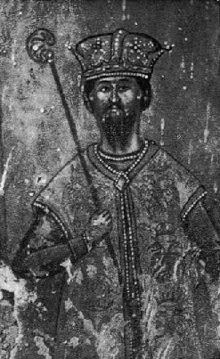Kostandin Shpataraku
Kostandin Shpataraku (fl. 1736–67) was an Albanian painter and decorator of 18th century.
He was born in Valesh village, Shpat region in Albania. The region is located in the southern highland of Elbasan, Albania, in today's Gjinar municipality, back then Ottoman Empire.[1][2]
He was a painter in the Orthodox tradition of icons and Byzantine church frescoes, active between 1736 and 1767. His works combine Byzantine tradition and Italian Renaissance influences.[2]
Shpataraku was beheaded by the Ottomans in Elbasan. His family took his body and buried him in his village, head apart from the rest of the body, so the Ottomans could not find his exact grave. A small chapel was built later to commemorate him. He is also commemorated as a saint by the locals, on September 21.[1]
Many of his icons are in Ardenica Monastery, St. Jovan Vladimir's Church near Elbasan, Vithkuq, and in the "Museum of Medieval Art" in Korce. Many of his works belong to private collections.[2] One of his associated works sold at a charity ball hosted by Liri Berisha, wife of the Albanian premier for 75,000 euros, raising discussions about a possible art-trafficking schema.[3]

References
- ↑ 1.0 1.1 Tomb and works of Kostandin Shpataraku (in Albanian)
- ↑ 2.0 2.1 2.2 Robert Elsie (2010), Historical Dictionary of Albania, Historical Dictionaries of Europe 75 (2 ed.), Scarecrow Press, p. 416, ISBN 978-0810861886
- ↑ "Albania Struggles to Catalogue its Unknown Treasures". Balkan Insight. Retrieved November 7, 2010.